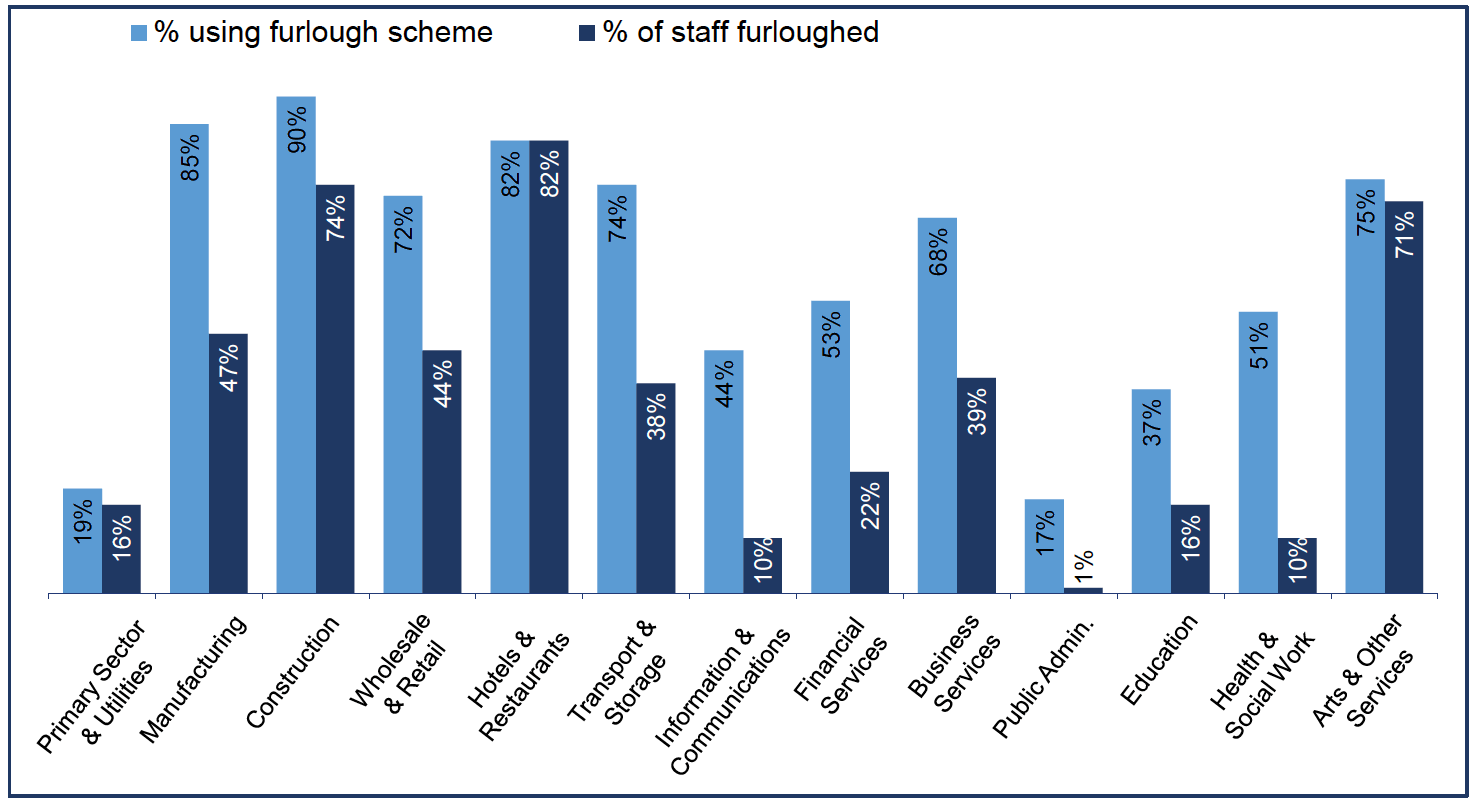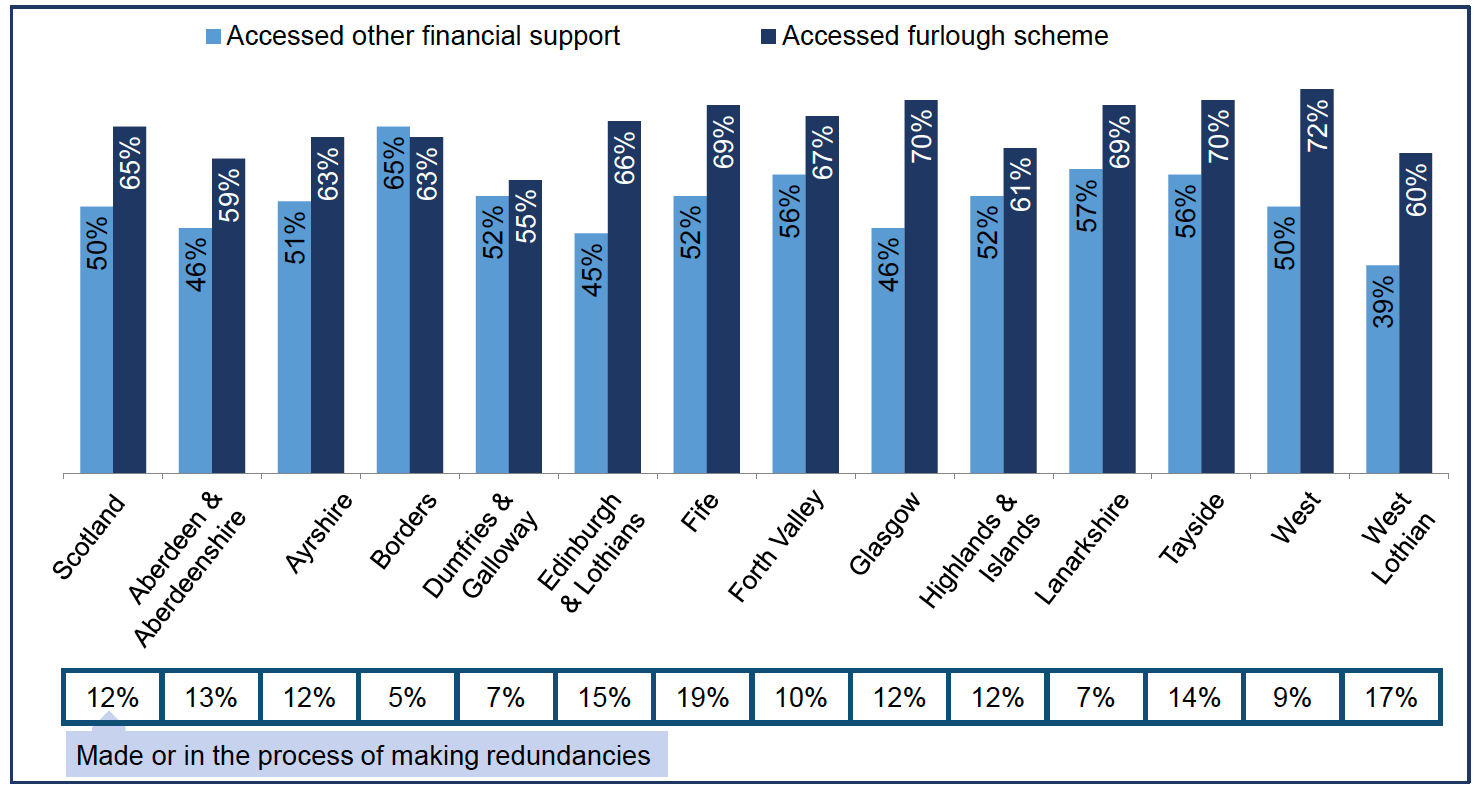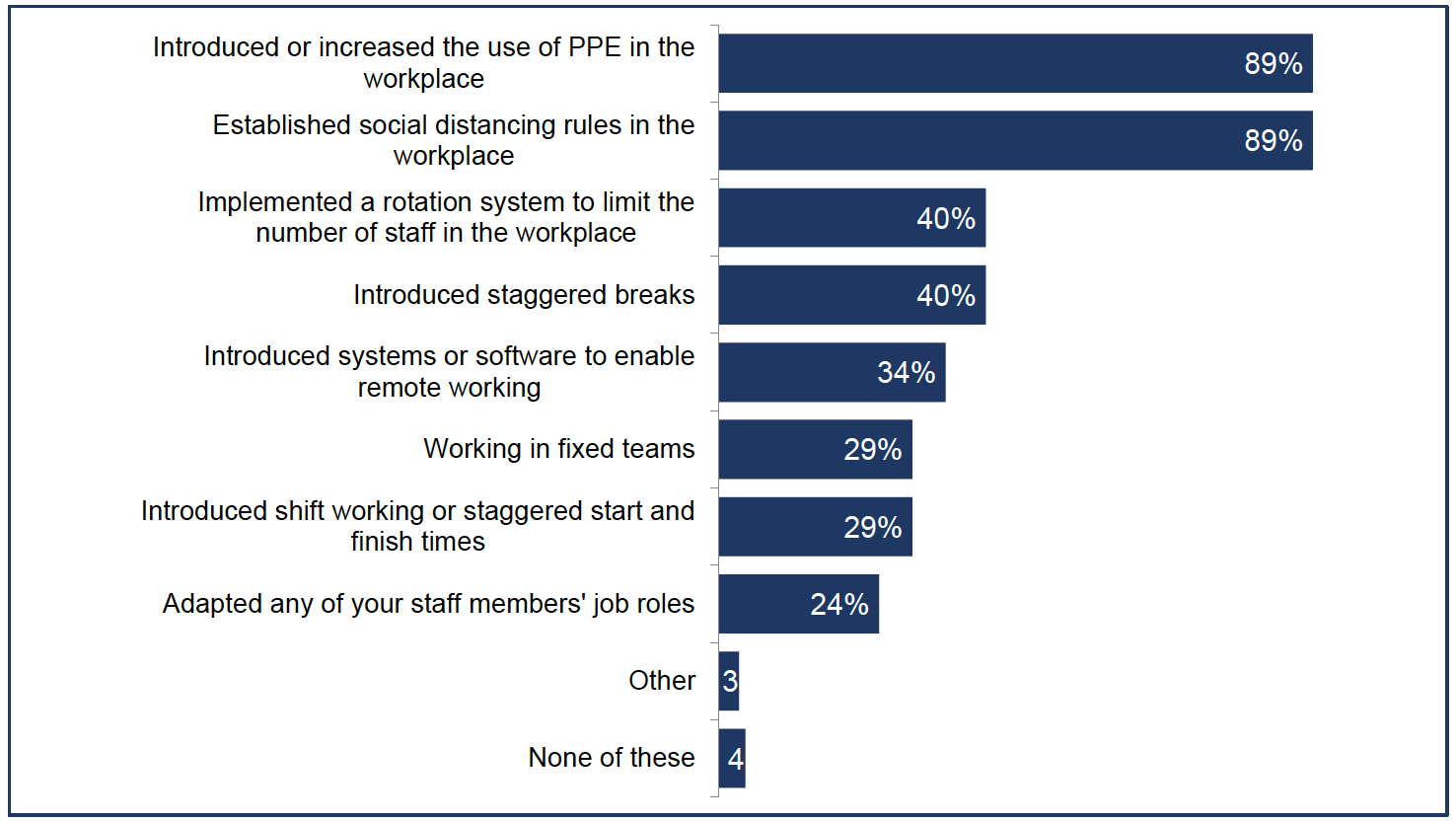Scottish Employer Skills Survey 2020
Results from the Scottish Employer Skills Survey 2020.
Response to COVID-19
This chapter looks at the impact of the COVID-19 pandemic on employers, including their use of support, their working practices and their staffing levels.
It is worth noting that furlough rates and redundancies have varied significantly over time depending on restrictions in place and changes to the UK Government's Coronavirus Job Retention Scheme Policy. Survey respondents were asked about their experiences up until the point in time at which they were interviewed. Fieldwork was undertaken during a period (October to December 2020) where the level of restrictions in different areas (and sectors) of Scotland were under constant review and changing frequently.[8]
Government-backed support
Overall, three-quarters (76%) of employers had accessed some form of government-backed support in response to the pandemic.
Two-thirds of employers (65%) said they had made use of the Coronavirus Job Retention Scheme, also known as the furlough scheme, and half of employers had accessed any government-backed financial support.
Of those who had not furloughed any staff, 30% had accessed some other form of government-backed financial support in response to the pandemic. Around a quarter of these (27%) said that other support had influenced their decision not to furlough staff via the Coronavirus Job Retention scheme.
Use of the furlough scheme
In total nearly two-thirds (65%) of employers had furloughed at least one member of staff in response to the pandemic.
In total around 36% of the workforce in Scotland had been furloughed at least once.
Mid-sized businesses were most likely to have furloughed any staff: 73% of those with 5-24 staff had done so, compared with around three-fifths of those with 2-4 staff (60%) or with 100 or more staff (57%).
Use of the furlough scheme varies widely by sector. Nine-in-ten (90%) of Construction firms had furloughed at least one member of staff, closely followed by Manufacturing (85%) and Hotels and Restaurants (82%). See Figure 20 for the sector breakdown.
The proportion of staff placed on furlough also varied widely by sector, from just 1% in the Public Administration sector to 82% in Hotels and Restaurants.

Base: All establishments (Scotland: 3,497; sector base sizes range from 54 in Financial Services to 692 in Wholesale and Retail).
Six-in-ten employers (60%) who furloughed staff said all staff that were furloughed were furloughed full-time; just over a third (37%) furloughed any staff for just part of their usual hours.
A quarter of establishments that had furloughed any staff (24%) had rotated furloughed staff between periods where they worked and periods on furlough. This was particularly common in the Education sector (52%), and in Hotels and Restaurants (39%) and Manufacturing (32%).
The majority of employers (71%) said staff had not to their knowledge undertaken any other activities such as training, volunteer work or working for another employer during their furlough. However, 12% said their staff had undertaken training and development activities, 8% knew of staff undertaking volunteering work and 7% knew of staff who had worked for another employer during their furlough.
Redundancies
One-in-eight employers (12%) had either made staff redundant or were in the process of doing so at the time of their interview.
Employers were most likely to have made or be making redundancies in the Hotels and Restaurants (29%) and Manufacturing (21%) sectors.
Of those who had made redundancies 90% had utilised the furlough scheme (while 9% making redundancies had not accessed this scheme), and just over half (53%) had received financial support from Government-backed sources (26% had not and 21% were unsure).
Of those who had made redundancies and had also utilised the furlough scheme, the vast majority (86%) said the staff that were made redundant had previously been furloughed.
Regional differences
Although the impact of the COVID-19 pandemic has been felt across all ROA regions, some had been more heavily impacted than others. Figure 21 shows how accessing the furlough scheme, accessing other Government-backed support and making redundancies varied by ROA region.
Use of the Coronavirus Job Retention Scheme (furlough) was highest in the West Region (72%) and lowest in Dumfries and Galloway (55%), Aberdeen and Aberdeenshire (59%) and Highlands and Islands (61%) Regions.
Use of government-backed financial support was highest in Borders Region (65%), and higher than average in Lanarkshire (57%) and Tayside (56%) Regions. It was lowest in West Lothian (39%) and Edinburgh and Lothians (45%) Regions.
Employers in ROA regions Fife, West Lothian, and Edinburgh and Lothians were particularly likely to have made redundancies during the period (19%, 17%[9] and 15% respectively). Employers were least likely to have made redundancies in Borders (5%) and Lanarkshire (7%) Regions.

Base: All establishments (Scotland: 3,497; regional base sizes range from 87 in West Lothian Region to 500 in Highlands and Islands Region).
"Regions" refer to ROA regions – see "Definitions" section of this report for more detail.
Further data on the use of the furlough scheme, redundancies and use of financial support can be found in Tables 56 to 61 of the Background Tables.
Working practices
Nearly all employers (96%) had changed their working practices in some way in response to the pandemic.
This included an increase in staff working from home and the changes required to make workplaces "COVID secure" by reducing the risk of transmission between people on site, including both staff and the public.
Homeworking
A third (35%) of employers reported that they had more staff working from home as a result of COVID-19. This was particularly common in Glasgow Region (46%), Edinburgh and Lothians Region (45%), and in Fife Region (40%).
By sector, an increase in homeworking in response to the pandemic was most common in the Public Administration (86%), Financial Services (70%), Business Services (61%), Information and Communications (55%) and Education (53%) sectors.
There were mixed views on the impact of increased homeworking on productivity. Whereas half (53%) felt productivity had been unaffected by the change, a third (33%) of those experiencing an increase in homeworking said that productivity had decreased. This was most common in the Business Services sector, where 41% had seen a decrease in productivity from increased homeworking, and in smaller businesses (38% of establishments with 2 to 4 employees had seen workforce productivity decrease, compared to just 12% of employers with 100 or more staff).
Conversely, one-in-nine (11%) said the productivity of the workforce had increased since homeworking had increased.
Further data on increases in homeworking can be found in Table 56 and 63 of the Background Tables.
Other working practices
Nearly all (96%) had made at least one other change (besides increased homeworking) to their working practices in response to the pandemic. Those that had not had to introduce any new working practices were all smaller employers: 93% of employers with 2-4 staff had made a change, whereas 100% of employers with 25 or more staff had adopted at least one new working practice.
The most common practices adopted was introducing or increasing the use of Personal Protective Equipment (PPE) in the workplace (89%) and establishing social distancing rules (89%).
Four-in-ten (40%) had implemented a rotation system to limit the number of staff in the workplace, and the same proportion (40%) had introduced staggered breaks thereby reducing contact between staff.
Other common adaptations included introducing systems or software to enable remote working (34%), working in fixed teams (29%), shift working and/or staggered start and finish times (29%) and adapting job roles (24%).
Further data on working practices adopted by employers due to COVID-19 can be found in Table 64 of the Background Tables.

Base: All establishments (3,497).
Training Response
Overall a quarter (26%) of employers said that the COVID-19 pandemic had an impact on their training plans.
Overall, 63% of establishments had plans to provide training to staff in the next year, of these three-quarters (75%) said this was due at least in part to the pandemic.
Training that had been arranged or funded specifically in response to the pandemic most commonly included infection prevention and control (69% of training establishments), use of personal protective equipment (PPE) (68%), identifying and assessing operational risks (60%) and using software or IT systems to support remote working (46%).
In total 83% of training establishments had provided training relating to health and safety around COVID-19 and 69% in new working practices introduced in response to COVID-19.
Overall, 27% of establishments who plan to provide training in the next 6 months said that at least some of this training would be related to COVID-19; this equates to 17% of all establishments.
Further data on the training response to COVID-19 can be found in Tables 67 and 68 of the Background Tables.
Contact
Email: FHEstatistics@gov.scot
There is a problem
Thanks for your feedback